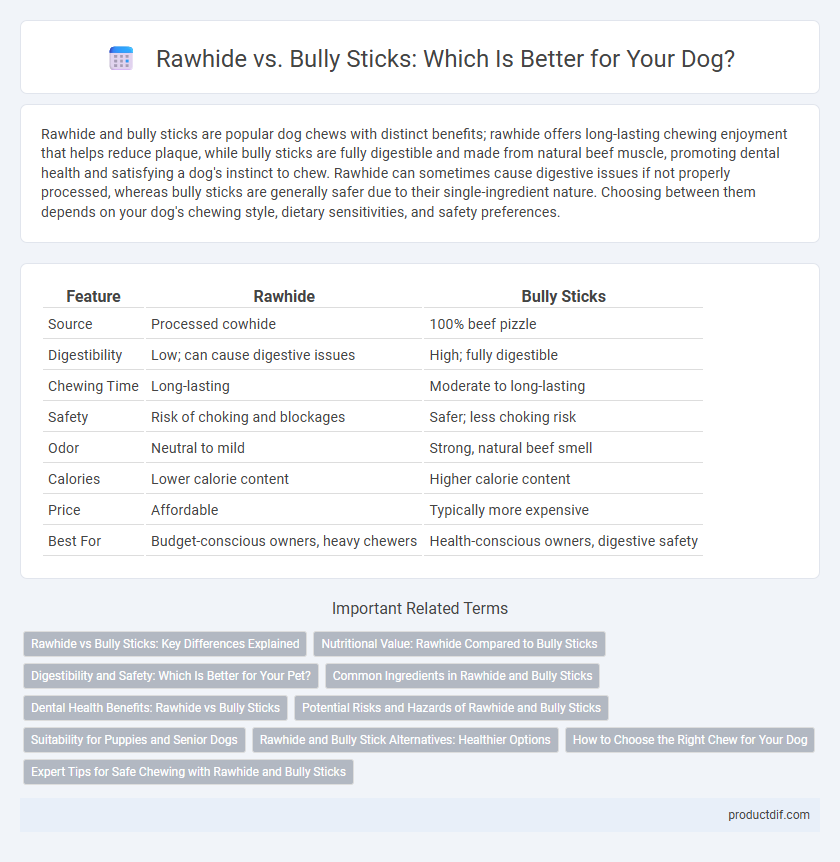Rawhide and bully sticks are popular dog chews with distinct benefits; rawhide offers long-lasting chewing enjoyment that helps reduce plaque, while bully sticks are fully digestible and made from natural beef muscle, promoting dental health and satisfying a dog's instinct to chew. Rawhide can sometimes cause digestive issues if not properly processed, whereas bully sticks are generally safer due to their single-ingredient nature. Choosing between them depends on your dog's chewing style, dietary sensitivities, and safety preferences.
Table of Comparison
| Feature | Rawhide | Bully Sticks |
|---|---|---|
| Source | Processed cowhide | 100% beef pizzle |
| Digestibility | Low; can cause digestive issues | High; fully digestible |
| Chewing Time | Long-lasting | Moderate to long-lasting |
| Safety | Risk of choking and blockages | Safer; less choking risk |
| Odor | Neutral to mild | Strong, natural beef smell |
| Calories | Lower calorie content | Higher calorie content |
| Price | Affordable | Typically more expensive |
| Best For | Budget-conscious owners, heavy chewers | Health-conscious owners, digestive safety |
Rawhide vs Bully Sticks: Key Differences Explained
Rawhide and bully sticks differ primarily in their source and digestibility; rawhide is made from the inner layer of cow or horse hides, often treated chemically, while bully sticks are made from beef pizzle and are fully edible. Rawhide tends to be tougher and less digestible, posing a higher risk of choking or gastrointestinal blockages, whereas bully sticks are softer, more digestible, and generally safer for dogs. Nutritionally, bully sticks offer higher protein content and fewer additives, making them a more natural and healthier chew option for pets.
Nutritional Value: Rawhide Compared to Bully Sticks
Rawhide and bully sticks differ significantly in nutritional value, with bully sticks offering higher protein content and natural digestibility, making them a healthier option for dogs. Rawhide is often lower in essential nutrients and can pose digestion challenges, as it is more processed and may contain fillers or chemicals. Choosing bully sticks supports better muscle health and energy levels due to their rich amino acids and minimal additives.
Digestibility and Safety: Which Is Better for Your Pet?
Rawhide chews are less digestible and pose higher choking and blockage risks compared to bully sticks, which are made from natural beef muscle and break down more safely in pets' digestive systems. Bully sticks are often recommended by veterinarians due to their easier digestibility and lower risk of causing gastrointestinal issues. Choosing bully sticks enhances pet safety and digestive health, especially for dogs prone to chewing hazards.
Common Ingredients in Rawhide and Bully Sticks
Rawhide is primarily made from the inner layer of cow or horse hides, consisting mainly of collagen, a protein that provides durability and chew resistance. Bully sticks come from the pizzle muscle of bulls, rich in natural proteins and single-ingredient composition, often free from additives or preservatives. Both treats offer high protein content but differ in source material and digestibility, influencing pet health and preference.
Dental Health Benefits: Rawhide vs Bully Sticks
Rawhide and bully sticks both support dental health by reducing plaque and tartar buildup through chewing, but bully sticks are generally more digestible and less likely to cause gastrointestinal blockages. Rawhide may sometimes carry risks related to choking or contamination, whereas bully sticks provide a natural, single-ingredient chew that promotes stronger gums and fresher breath. Pet owners seeking effective dental chews often prefer bully sticks for their superior safety profile and enhanced cleaning benefits.
Potential Risks and Hazards of Rawhide and Bully Sticks
Rawhide treats pose choking hazards and potential gastrointestinal blockages if ingested in large pieces, while poorly processed rawhide can harbor bacteria leading to infections. Bully sticks are generally safer but still carry risks of bacterial contamination and can cause digestive upset if overconsumed. Pet owners should monitor chewing habits and choose high-quality, thoroughly cleaned products to minimize health risks.
Suitability for Puppies and Senior Dogs
Rawhide chews are often harder and less digestible, making them better suited for senior dogs with stronger chewing abilities, while bully sticks are softer and more easily digestible, ideal for teething puppies and dogs with sensitive stomachs. Puppies benefit from bully sticks as they promote dental health without the risk of splintering that rawhide may pose. Senior dogs with dental issues might tolerate bully sticks better, but their reduced chewing strength often makes softer textures more appropriate.
Rawhide and Bully Stick Alternatives: Healthier Options
Rawhide and bully sticks often raise concerns due to potential digestive issues and contamination risks. Healthier alternatives include natural chews like pig ears, antlers, and Himalayan yak bones, which provide safer, nutrient-rich options that support dental health and reduce choking hazards. Selecting these alternatives ensures pets enjoy long-lasting, satisfying chews without compromising safety or nutrition.
How to Choose the Right Chew for Your Dog
Choosing the right chew for your dog depends on factors such as size, chewing strength, and dietary sensitivities. Rawhide offers a durable option that helps with dental health but can pose digestive risks if swallowed in large pieces, while bully sticks are fully digestible and made from natural beef muscle, providing a safer alternative with high protein content. Always supervise your dog during chewing and opt for treats that match their chewing habits and health needs to ensure safety and enjoyment.
Expert Tips for Safe Chewing with Rawhide and Bully Sticks
Veterinarians recommend supervising dogs when chewing rawhide and bully sticks to prevent choking hazards and digestive blockages. Rawhide should be chosen in high-quality, fully digestible forms processed without harmful chemicals, while bully sticks offer a natural alternative rich in protein and generally easier to digest. Regularly inspect chews for small, swallowable pieces and discard any that become too small to ensure safe chewing experiences for pets.
Rawhide vs Bully Sticks Infographic

 productdif.com
productdif.com